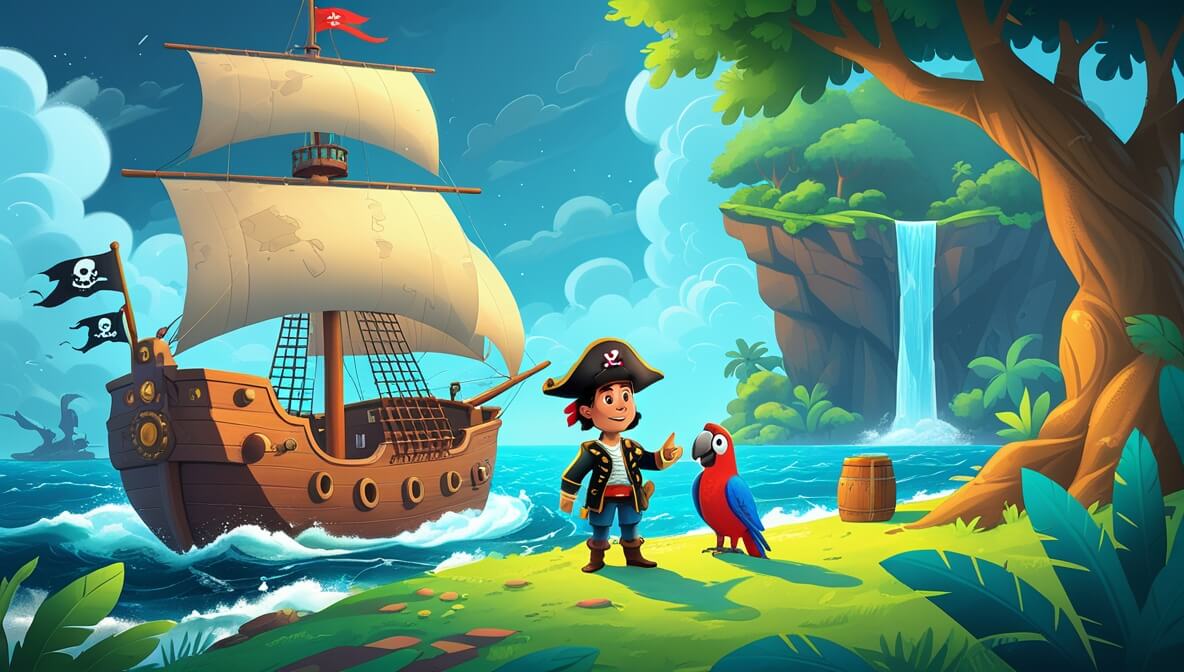Join Captain Marlowe and his brave crew as they embark on an adventure to find the legendary Golden Anchor, hidden on the mysterious Skull Island. Along the way, they face stormy seas, cunning rivals, and discover the true treasure of friendship.
Age Recommendation
3 – 12 years
Characters
Characters:
- Captain Marlowe (a courageous and wise pirate leader)
- First Mate Timbers (a loyal and clever sailor)
- Pearl the Parrot (a colorful bird with a knack for finding clues)
- Captain Crowe (a sneaky rival pirate)
Story
Under the bright, shimmering sun, **Captain Marlowe** stood on the deck of his ship, the Sea Mist, gazing at the old map he had in his hand. The map was said to lead to the **Golden Anchor**, a treasure so legendary that many had tried and failed to find it. “This will be our greatest adventure yet!” exclaimed First Mate Timbers, his eyes sparkling with excitement.
A Mysterious Map
The map was full of strange symbols and lines, but Pearl the Parrot squawked, “Skull Island! Skull Island!” pointing with her beak to a spot on the map. “Pearl’s right,” said Captain Marlowe, “It leads to Skull Island. That’s where we’ll find the Golden Anchor.”
Setting Sail
With the sails unfurled, the Sea Mist cut through the waves, the wind whistling through the rigging. “Hold steady, crew!” Captain Marlowe called out as the sky darkened with clouds. A fierce storm had appeared, tossing the ship like a toy. But the crew **worked together**, battling the storm with bravery and skill.
The Rival’s Challenge
Just as the storm subsided, another ship loomed on the horizon. It was the Black Raven, captained by the cunning Captain Crowe. “Ahoy, Marlowe!” shouted Captain Crowe, grinning mischievously. “That treasure is mine!” Crowe’s crew readied their cannons, but Marlowe called to his crew, “Prepare for a race! We’ll see who reaches the island first!”
The Race to Skull Island
Both ships sped through the sea, the **wind filling their sails**. Pearl flew ahead, guiding with her sharp eyes. As the Sea Mist neared Skull Island, Captain Marlowe spotted a hidden lagoon behind a waterfall. “That’s it!” he shouted. They steered into the lagoon, leaving the Black Raven behind.
The Golden Anchor
On the island, they climbed through dense jungle, following the map’s clues. Finally, they arrived at a **mysterious cave**. Inside, glinting in the dim light, was the **Golden Anchor**, encrusted with jewels. “We found it!” cried Timbers, but Marlowe noticed something even greater. “Look around, mates,” he said, pointing to the lush greenery and sparkling streams. “The real treasure is this beautiful island we’ve discovered together.” They agreed, realizing the adventure and their friendship were the true rewards.
The end.
Moral of the Story
The story teaches that while seeking great treasures, the most valuable discoveries are often the friendships and experiences we gain along the way. Working together and appreciating nature are just as rewarding as finding gold.
Questions to Think About
- What did Captain Marlowe and his crew learn on their adventure?
- How did teamwork help them reach Skull Island?
- Why do you think Captain Marlowe valued the island more than the Golden Anchor?
- What would you do if you found a treasure map?
- What qualities make a good leader like Captain Marlowe?
Do You Know
- Many pirate legends are inspired by real-life explorers and their adventures on the high seas.
- The term “parrot” comes from the French word “perroquet,” which means a small bird that talks.
Word Explorer
- Lagoon: A shallow body of water separated from the sea by sandbars or coral reefs.
- Rigging: The system of ropes, cables, or chains used to support a ship’s masts and control its sails.
- Legendary: Something that is famous and well-known, often for being valuable or special.
Emotions in the Story
- Excitement: When Captain Marlowe’s crew set off on their adventure, full of hope and curiosity.
- Bravery: As the crew faced the storm and worked together to keep the ship safe.
- Joy: When they discovered the island and realized the true treasure was their journey and friendship.
Color Your Scene
Imagine the moment Captain Marlowe and his crew find the hidden lagoon behind the waterfall on Skull Island. Picture the lush green jungle, the sparkling blue water, and the colorful parrots flying above. Draw this scene using your most vibrant colors.
Parents’ Corner
This story is a great way to talk to your child about:
The value of friendship: Discuss how Captain Marlowe and his crew relied on one another, and how true friendship is a treasure itself.
Appreciating nature: Encourage your child to notice the beauty around them and understand the importance of preserving it.
Leadership and courage: Talk about how Captain Marlowe showed leadership by guiding his crew and facing challenges bravely.
Overcoming challenges: Use the crew’s battle with the storm as an example of how we can face and overcome difficulties in life.











